This was the second safest Westminster constituency in Northern Ireland in 2019. Claire Hanna (SDLP) enjoyed a 15,401 majority over the second placed Emma Little-Pengelly (DUP) who had been the MP for two years. The constituency always returned a unionist from the time it was first created in 1885 up until 2005 when it was taken by the SDLP, which held it until 2017.
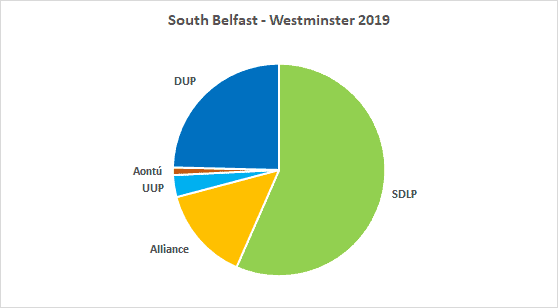
The changes made to the constituency boundaries last November were not substantial.
Candidates
Dan Boucher, TUV
Áine Groogan, Green
Claire Hanna, SDLP
Michael Henderson, UUP
Tracy Kelly, DUP
Kate Nicholl, Alliance
Sinn Féin are not standing in this constituency.
Candidates’ Electoral History
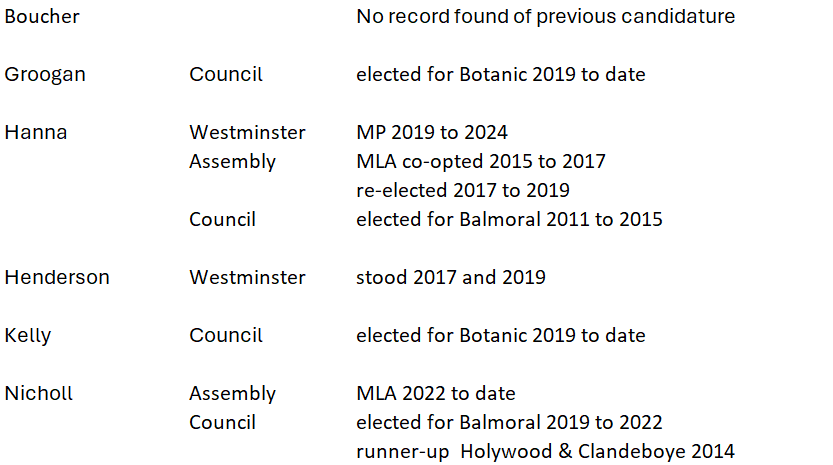



Vote shares by designation
There were no changes to the boundaries between 2010 and 2023.
First of all take a look at the results excluding those for Westminster elections.
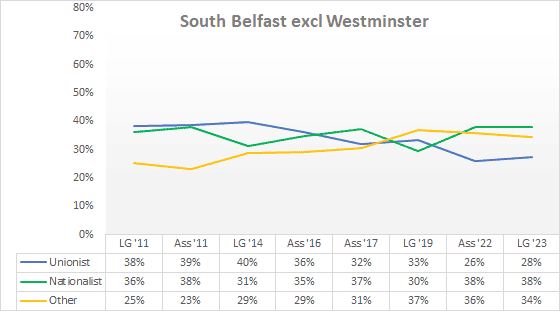

Please note that some Local Government electoral areas cross constituency boundaries which means that the LG figures have been estimated.
At the beginning of this period the constituency was one where unionist and nationalist jostled for the top spot. It changed to one where all three designations vied with each other. It has now become one where nationalists and Others contend. Unionists have dropped 12% points on their trend line, Others have risen 10%, while nationalists have put on 1%.
Now look at the same figures with the Westminster results added in.
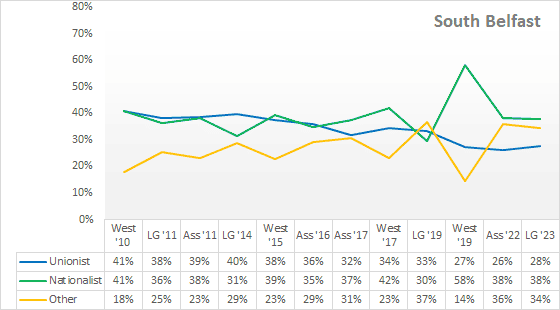

Normally where there is a tight unionist/nationalist contest the squeeze on the Other vote benefits both unionists and nationalists. South Belfast is unusual in that the benefit only goes one way, from Other to nationalist. The tactical vote is exclusively anti-DUP. And in 2019 it went through the roof.
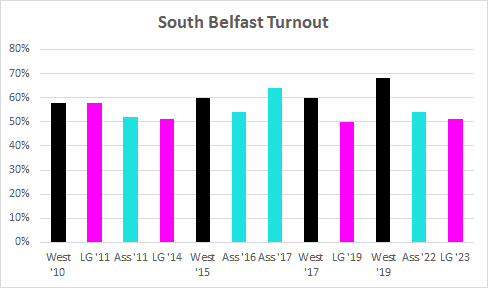

The other thing that happened in 2019 was an 8% point increase on the normal turnout in Westminster elections, making it only 2% points lower than Fermanagh South Tyrone which was the highest in Northern Ireland. That represents 5,600 extra voters. It appears even some normally stay-at-home voters joined in the anti-DUP, or possibly anti-Brexit, tactical vote.
It is worth recalling that this constituency had voted by more than 2 to 1 to Remain.
We will examine the 2019 tactical vote by party later on. But first some context.
Vote share by party in Assembly and Local Government Elections
Because of Westminster tactical voting, changes in the underlying strength of the principal parties within a constituency can best be understood by looking at their performance in other elections.
Since this looks more like a section of the London Underground than an electoral chart, I have increased the scale to reduce the confusion as much as possible.
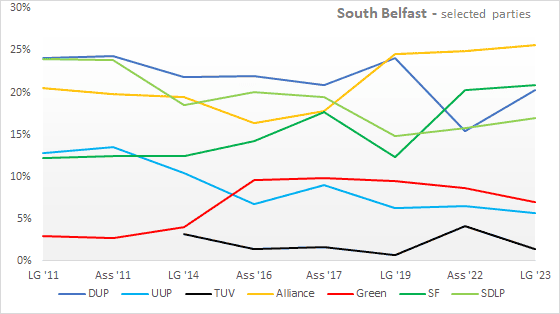

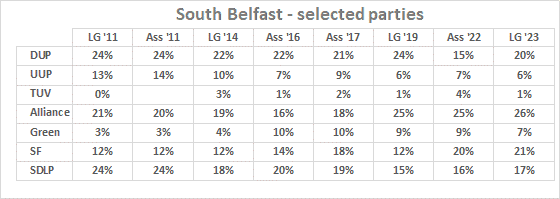

Although a lot of other parties contested these elections from time to time, none achieved more than 2%, with the exception of the PUP and NI21 which hit 4% and 5% respectively in 2014.
Alliance has come from the third spot, overtaking both the DUP and SDLP to become the largest party in the constituency, trending upwards by 6% points. Sinn Féin has also surpassed the DUP to move into second place, with a 7% upward trend. And in last year’s Council elections the SDLP dropped to fourth (down 9%) behind the DUP (down 5%).
The UUP has also fared badly (trending down 8% points), losing half of its voters. They have been behind the Greens since 2016.
The Greens retain significant support (with a trend line up 6% points) but have faded slightly since their peak in the Assembly elections of 2016 and 2017, losing their seat in 2022 to Alliance. They actually came in 3% points below trend in the last Council elections.
Vote share in Westminster elections
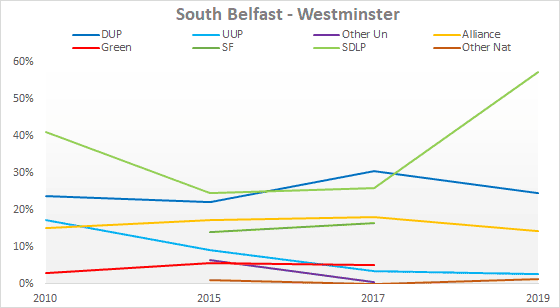

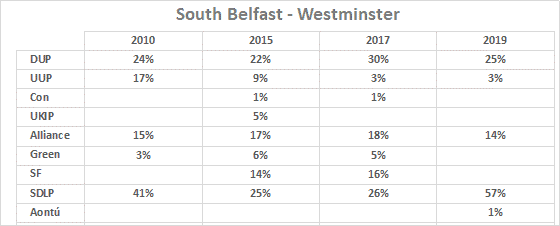

The 2019 tactical vote resulted in a party with a base of 15% to 16% (as shown in the Council and Assembly elections directly before and after 2019) adding another 29 or 30% points to their total.
It appears that the tactical vote was made up of three, or more likely four, elements.
First, there was the normal shift of some Other voters to the SDLP in order to keep the DUP out. Based on 2017 that would have accounted for about 7% points.
Second, the normal shift from other nationalists to the SDLP. Again, based on 2017 that would account for about 4% points.
Third, the withdrawal from the contest of other parties. Sinn Féin would have contributed up to another 16% and the Greens 5%. The local Green MLA actively campaigned for the SDLP.
And possibly fourth, the higher turnout, which could have contributed up to 8%.
That lot could total about 55% to 56%. The SDLP achieved 57%.
At face value the most questionably of these hypotheses is the fourth. Could all of the higher turnout really be to the benefit of the SDLP? Well, the total unionist vote was actually down over 2,000 on 2017, and the Others over 3,000. There was nowhere else those 5,600 extra voters could have gone.
The boundary changes
Calculating the effects of changes to constituency boundaries is not straightforward since there is no record of precisely how past votes for each party were distributed geographically. Necessarily this involves estimates and assumptions, and these may differ. For many years the UK media have all used the calculations provided by two academics, Rallings and Thrasher, to provide a notional result of how each constituency would have voted at the previous general election if the latest boundaries had been in force. For Northern Ireland their inputs are provided by Nicholas Whyte. These will be the base from which the media will report voting swings when constituency results are declared.
I used different assumptions for my own calculations of the notional vote which resulted in slightly different outcomes. In the following chart the Actual result in 2019 is compared with my estimate and the R&T estimate.
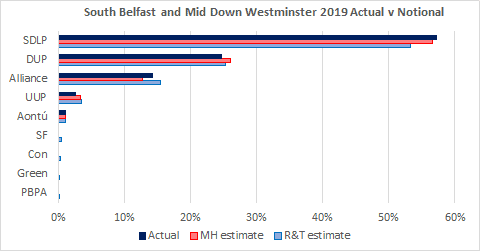

This gives different notional majorities for 2019.
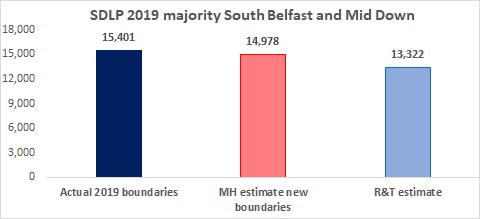

Resources
In addition to money, the other key resource for an election campaign is the level of constituency work running up to the campaign, and the manpower available in the campaign itself. When it comes to constituency work MP’s and MLA’s have the advantage of an allowance for constituency offices and for a staffing. The amount of staffing money is specified, but MP’s and MLA’s can choose to allocate it to fewer higher-paid staff or a greater number of lower-paid staff.
When it comes to manpower for canvassing and leafleting a party’s elected representatives normally form the core of the group available. Party’s may also choose to bring in helpers from neighbouring constituencies which they have no hope of winning.
The Index Total for each party gives some idea of the relative strength of each party locally.
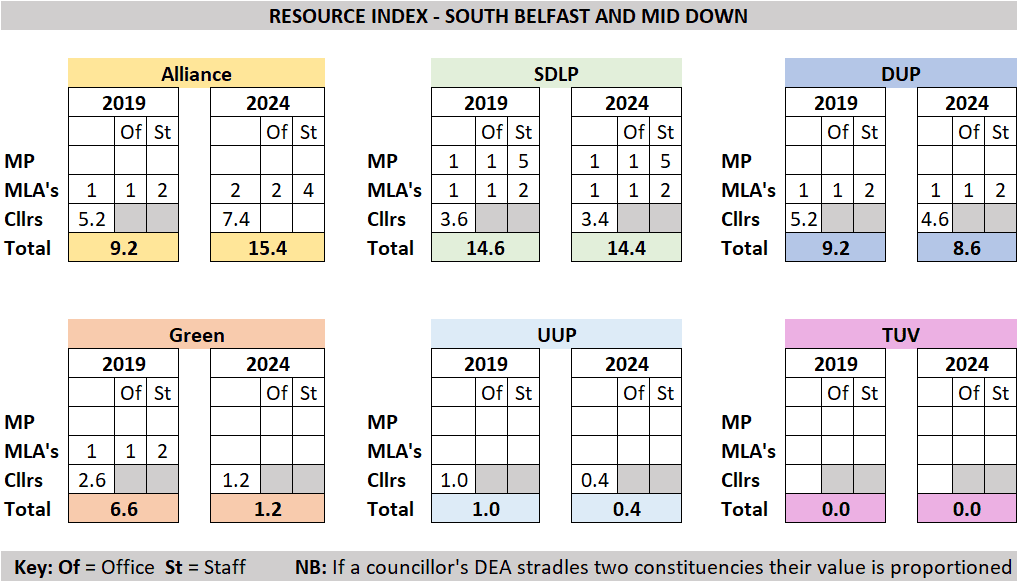

Alliance has gained a major boost in resources since 2019. It is the only party with 2 MLA’s in the constituency and also has the most councillors. In resource term this puts them and the SDLP on roughly equal footings. Alliance are likely to have more people on the ground, while the SDLP has the benefit of a high-profile incumbent.
Alliance will be unable to leverage its personnel advantage by bringing in additional workers from elsewhere, since these will be needed in East Belfast, North Down and Lagan Valley. The SDLP, on the other hand, while it is diminished in surrounding constituencies compared to 2019, has no such constraints.
Factors possibly assisting the SDLP
27.9% points ahead of DUP at the last election.
Their MP has enjoyed the advantage of paid staffing for constituency case work and the platform from which to build a bigger personal vote.
SF not standing again.
Factors possibly harming the SDLP
Boundary changes could subtract between 1 and 3% point from the previous SDLP share.
Green candidate standing. This could subtract up to 4% points from the SDLP share based on latest vote shares.
Any reduction in tactical voting by Alliance supporters occasioned by perception that there was no longer a threat from the DUP. This could arise from the size of the SDLP’s 2019 majority and/or the TUV splitting of the DUP vote. A total disappearance of Alliance tactical switchers could cost the SDLP up to 11% points of share, based on the latest Assembly and Council vote shares.
Drop in turnout back to historical levels. This could remove up to 8% points from the SDLP share.
Any lower turnout by SF voters or voting for other parties. What we cannot know is if the proportion of SF supporters who came out to vote last time will remain as high if they now believe that an DUP defeat is inevitable. At the last Assembly election in South Belfast only 49% of SF voters transferred to the SDLP. 37% picked Other parties as their second choice (of which 24% was Alliance). And 7% did not transfer at all. What sort of encouragement Sinn Féin gives their supporters to turnout for the SDLP could also make a difference. Would SF be better pleased to see a substantial reduction in the SDLP vote? At its maximum this could subtract 8% points from the SDLP share.
Factors possibly assisting the DUP
Boundary changes could add 1% point to its previous share
Factors possibly harming the DUP
The TUV candidate could subtract up to 4% points share from DUP, at the TUV’s 2022 Assembly vote share.
Alliance
Alliance is the wild card in this election. Historically the SDLP successfully squeezes its votes in South Belfast Westminster elections, and it did so particularly badly last time.
If Alliance were able to avoid a squeeze this time, their latest Assembly and Council votes would give them a 25/26% base. In a Westminster election they might hope to squeeze another 3% points or so from the Greens. Add in something for the increase in resources due to their extra MLA and councillors and, speculatively, some votes from Sinn Féin supports who lack a candidate of their own, and they could be in the 30% to 35% zone. At the top end of that range they could be neck-and-neck with the bottom end of the SDLP on a really bad day. However, those are four big “ifs” in four little sentences.
In practice, I imagine that Alliance would be very happy with a clear second place and a substantial cut in the SDLP majority, setting them up for a strong challenge in 2028 or 2029. They are probably following a two-election strategy with their new Westminster candidate.
Conclusion
The absence of Sinn Féin ensures that the SDLP will gain more votes than the DUP which could drop into third place.
Absent an Alliance earthquake, this looks very much like another SDLP win, probably with a significantly reduced majority.
Michael Hehir is a retired sales and marketing manager. He studied in Northern Ireland but now lives between England and Italy.
Discover more from Slugger O’Toole
Subscribe to get the latest posts to your email.
Source link




